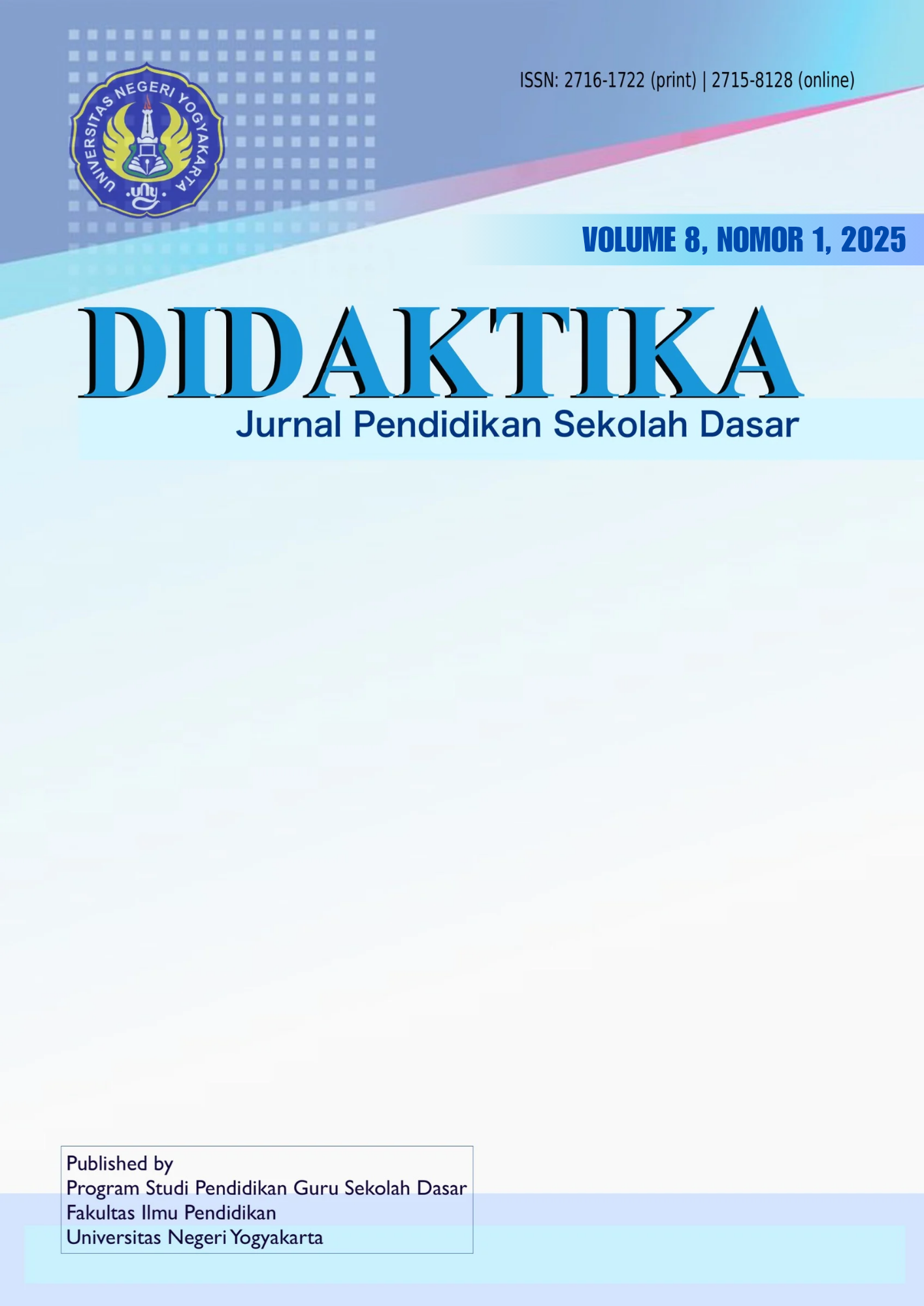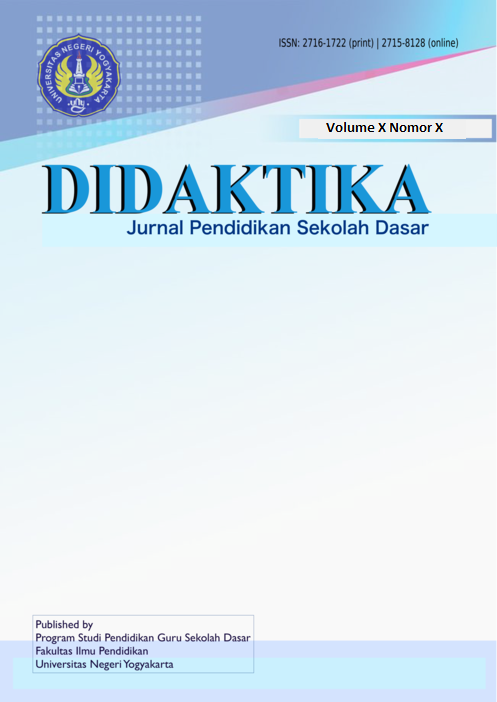Enhancing Students' Reading Literacy through the Implementation of Reading and Writing Across the Curriculum (RWAC) Using BukuAku
Abstract
This study evaluated the effectiveness of BukuAku, an interactive digital library application, in enhancing elementary school students’ reading literacy through the Reading and Writing Across the Curriculum (RWAC) approach. As digital learning tools become increasingly integral in early education, this study aimed to assess the impact of BukuAku on students’ reading comprehension using a quantitative research design. A quasi-experimental one-group pretest–posttest design was implemented involving 30 third-grade students over a four-month intervention period (January–April 2025). Two main instruments were employed in this study. The first instrument was the Lumina Testing Service (LTS), a Lexile-based quantitative reading assessment tool that is widely used internationally and supported by documented validity and reliability. The second was BukuAku, a digital library that provided leveled digital texts, audio narration, and quizzes to support the learning process. Reading proficiency was measured using the LTS before and after the intervention. Statistical analysis using a paired samples t-test revealed a significant increase in students’ Lexile scores, from a mean of 700.17 (SD = 26.375) in the pretest to 832.33 (SD = 39.277) in the posttest. These results demonstrate a substantial improvement in reading comprehension following the intervention. The findings support the efficacy of integrating digital literacy tools with cross-curricular reading and writing approaches to strengthen reading comprehension in early grades. This study contributes to the empirical literature on educational technology integration and highlights the value of structured, interactive literacy interventions. Future research is recommended to explore long-term impacts and broader implementation across diverse educational context.
References
Aisyah, & F, T. (2022). Literasi digital untuk meningkatkan minat baca siswa SMA pada pembelajaran daring. IQRA’: Jurnal Perpustakaan Dan Informasi, 16(1), 18–29.
BukuAku. (2022). Landlord. BukuAku. https://bukuaku.id/id/landlord
Campbell, L. O., Howard, C., Lambie, G. W., & Gao, X. (2022). The efficacy of a computer‑adaptive reading program on grade 5 students’ reading achievement scores. Education and Information Technologies, 27(6), 8147–8163. https://doi.org/10.1007/s10639-022-10953-5
Deci, E. L., & Ryan, R. M. (2000). The "what" and "why" of goal pursuits: Human needs and the self-determination of behavior. Psychological Inquiry, 11(4), 227–268. https://doi.org/10.1207/S15327965PLI1104_01
Elliot, A. J., & McGregor, H. A. (2001). A 2×2 achievement goal framework. Journal of Personality and Social Psychology, 80(3), 501–519. https://doi.org/10.1037/0022-3514.80.3.501
Firmansyah, A. (2023). Kaperpusnas: Koleksi buku di sekolah belum akomodasi kebutuhan siswa. ANTARA News. https://www.antaranews.com/berita/3460938/kaperpusnas-koleksi-buku-di-sekolah-belum- akomodasi-kebutuhan-siswa
Guo, Y., Puranik, C., Kelcey, B., Sun, J., Dinnesen, M. S., & Breit-Smith, A. (2020). The role of home literacy practices in kindergarten children’s early writing development: A one-year longitudinal study. Early Education and Development, 31(6), 1–23.
Henson, K. T. (2015). Curriculum planning: Integrating multiculturalism, constructivism, and education reform (5th ed.). Waveland Press.
Huang, Y.-M., Liang, T.-H., Su, Y.-N., & Chen, N.-S. (2022). Empowering personalized learning with digital reading platforms: Effects on engagement and comprehension. Computers & Education, 184, 104517.
Jewitt, C. (2008). Multimodality and literacy in school classrooms. Review of Research in Education, 32(1), 241–267.
Leu, D. J., Forzani, E., Rhoads, C., Maykel, C., Kennedy, C., & Timbrell, N. (2013). The new literacies of online research and comprehension: Rethinking the reading achievement gap. Reading Research Quarterly, 46(3), 260–277.
Mangvwat, S. E., & Meshak, V. J. (2022). Enhancing Literacy Development in Nigeria through Reading and Writing Skills Development. Journal of Education and Practice, 6(1), 48–59.
MetaMetrics Inc. (2020, August). Lexile® Measures Overview. MetaMetrics Inc. Retrieved from https://metametricsinc.com/wp-content/uploads/2020/08/Lexile-Measures-Overview.pdf
Moje, E. B., Ciechanowski, K. M., Kramer, K., Ellis, L., Carrillo, R., & Collazo, T. (2004). Working toward third space in content area literacy: An examination of everyday funds of knowledge and Discourse. Reading Research Quarterly, 39(1), 38–70. https://doi.org/10.1598/RRQ.39.1.4
Moltudal, S. H., Krumsvik, R. J., & Høydal, K. L. (2022). Adaptive Learning Technology in primary education: Implications for professional teacher knowledge and classroom management. Frontiers in Education, 7, 830536. https://doi.org/10.3389/feduc.2022.830536
Nasihah, F., & Tabroni, I. (2022). Fostering Literacy Culture through Reading and Writing Movement. Jurnal Pengabdian Masyarakat Bestari, 1(8), 779–792.
OECD. (2019). The future of education and skills 2030: OECD education working papers, No. 203. OECD Publishing.
Quraishi, T., Ulusi, H., Moihd, A., & Hakimi, M. (2023). Empowering students through digital literacy: A case study of successful integration in a higher education curriculum. Journal of Digital Learning and Distance Education, 2(8), 668–681.
Shanahan, T., & Shanahan, C. (2008). Teaching disciplinary literacy to adolescents: Rethinking content-area literacy. Harvard Educational Review, 78(1), 40–59. Retrieved from https://dpi.wi.gov/sites/default/files/imce/cal/pdf/teaching-dl.pdf
Smith, M., Turner, J., Sanford-Moore, E., & Koons, H. H. (2016). The Lexile Framework for Reading: An Introduction to What It Is and How to Use It. In Q. Zhang (Ed.), Pacific Rim Objective Measurement Symposium (PROMS) 2015 Conference Proceedings (pp. 411–424). Springer.
Sweller, J. (2010). Element interactivity and intrinsic, extraneous, and germane cognitive load. Educational Psychology Review, 22(2), 123–138. https://doi.org/10.1007/s10648-010-9128-5
Tomlinson, C. A. (2014). The differentiated classroom: Responding to the needs of all learners (2nd ed.). ASCD.
United Nations Educational, S. and C. O. (2017). Education for sustainable development goals: Learning objectives. UNESCO Publishing. https://unesdoc.unesco.org/ark:/48223/pf0000247444
Vaughn, S., Martinez, L. R., Wanzek, J., Roberts, G., Swanson, E., & Fall, A. M. (2016). Improving content knowledge and comprehension for English language learners: Findings from a randomized control trial. Journal of Educational Psychology, 108(3), 1–17.
Vygotsky, L. S. (1978). Mind in society: The development of higher psychological processes (M. A.-J.-S. Cole V. A2_3 - Scribner S. A2_4 - Souberman E., Ed.). Harvard University Press.
Wu, J., & Chen, D.-T. v. (2020). A systematic review of educational digital storytelling. Computers & Education, 147, 103786.
Zimmerman, B. J. (2002). Becoming a self-regulated learner: An overview. Theory into Practice, 41(2), 64–70. https://doi.org/10.1207/154304502753458703
Downloads
Published
How to Cite
Issue
Section
Citation Check
License
Copyright (c) 2025 Amy Theresia Sipayung, Asep Herry Hernawan, Ahmad Fajar Fadlillah

This work is licensed under a Creative Commons Attribution-ShareAlike 4.0 International License.
- Authors retain copyright and grant the journal right of first publication with the work simultaneously licensed under a Creative Commons Attribution License that allows others to share the work with an acknowledgement of the work's authorship and initial publication in this journal.
- Authors are able to enter into separate, additional contractual arrangements for the non-exclusive distribution of the journal's published version of the work (e.g., post it to an institutional repository or publish it in a book), with an acknowledgement of its initial publication in this journal.
- Authors are permitted and encouraged to post their work online (e.g., in institutional repositories or on their website) prior to and during the submission process, as it can lead to productive exchanges, as well as earlier and greater citation of published work.







